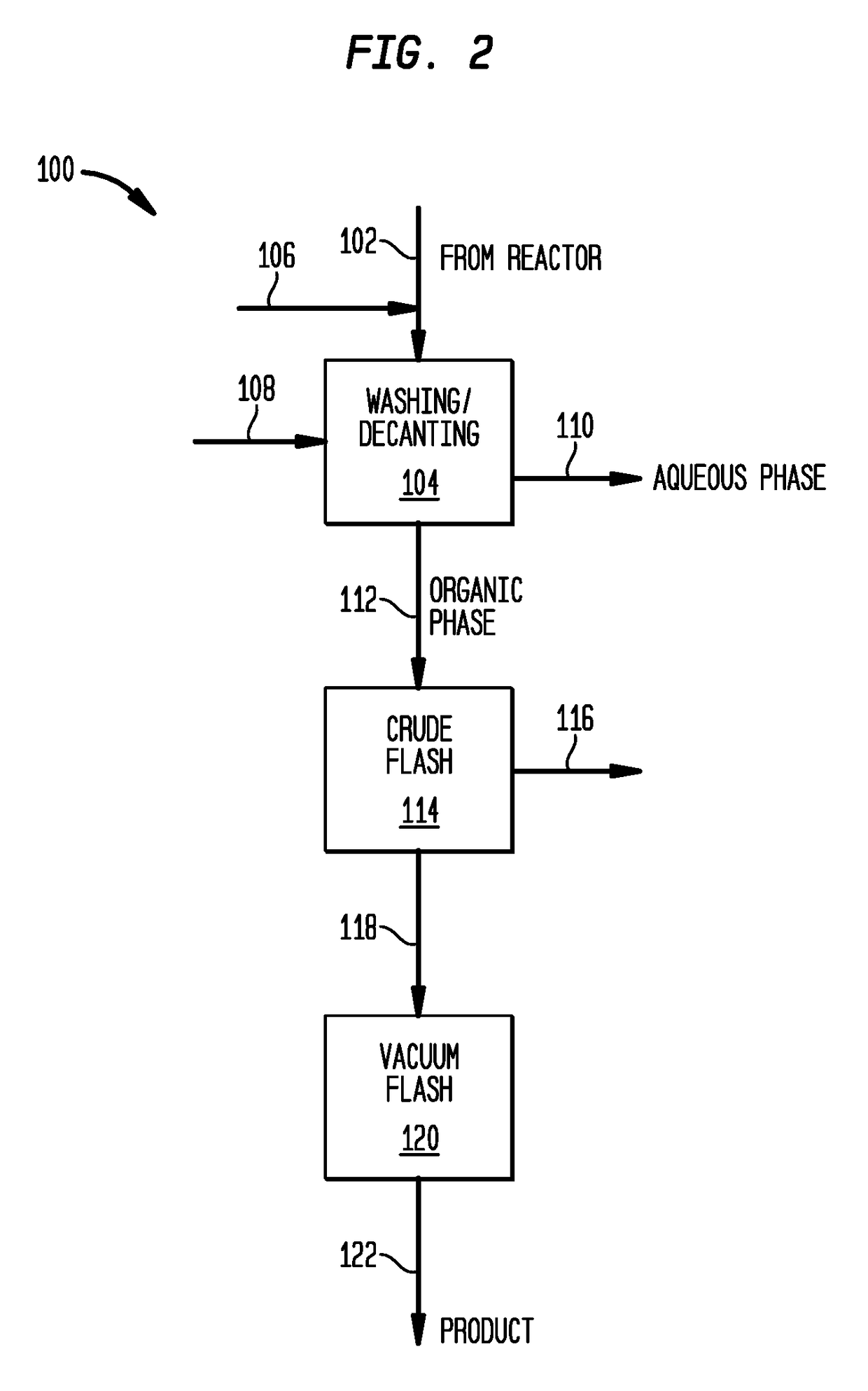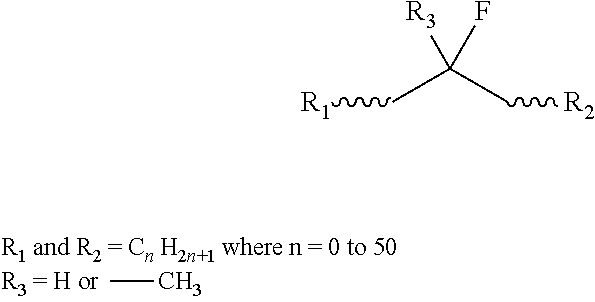Low-fluoride, reactive polyisobutylene
- Summary
- Abstract
- Description
- Claims
- Application Information
AI Technical Summary
Benefits of technology
Problems solved by technology
Method used
Image
Examples
example 1
[0076]Utilizing the apparatus shown in FIG. 1, isobutylene feedstock having the composition shown in Table 2 is diluted in a 1:1 weight ratio with isobutene and is polymerized in the liquid phase at a temperature of 10° C. and an average residence time of less than 15 minutes. BF3 and methanol catalyst modifier are added in a methanol:BF3 ratio of 1.6:1. 1 millimole BF3 is used per mole of isobutylene introduced into the reactor. The crude product has a residual fluoride content of less than 200 ppm F by weight. Following withdrawal from the reactor, the reaction mixture is quenched to deactivate the catalyst, washed with water to remove salts and distilled to remove oligomers as discussed in connection with FIG. 2. The purified product has a total fluoride content of less than 10 ppm by weight fluoride, a molecular weight, Mn of 2100 Daltons and an alpha content of 79 mol. %.
example 2
[0077]Isobutylene feedstock having the composition of Table 2 is blended in a 1:1 weight ratio with the isobutylene raffinate-1 feedstock of Table 4. The blend is then diluted in a 1:1 weight ratio with isobutane and is polymerized in the liquid phase utilizing the apparatus shown in FIG. 1 at a temperature of 10° C. and an average residence time of about 20 minutes. BF3 and isopropanol catalyst modifier are added in a isopropanol:BF3 ratio of 1.8:1. 1 millimole BF3 is used per mole of isobutylene introduced into the reactor. The crude product has a residual fluoride content of less than 200 ppm F by weight. Following withdrawal from the reactor, the reaction mixture is quenched to deactivate the catalyst, washed with water to remove salts and distilled to remove oligomers as discussed in connection with FIG. 2. The purified product has a total fluoride content of less than 8 ppm by weight fluoride, a molecular weight, Mn of 1050 Daltons and an alpha content of 83 mol. %.
examples 3-6
[0078]These examples illustrate the surprising and profound effect of LB / IsoB index on the fluoride ride content of purified PIB polymer recovered from a reactor under a given set of conditions.
[0079]Isobutylene feedstock was fed to a reactor and was polymerized in the liquid phase utilizing the feed and process features shown in Table 6. Following withdrawal from the reactor, the reaction mixture was quenched to deactivate the catalyst, washed with water to remove salts and distilled to remove oligomers as discussed in connection with FIG. 2. Examples 3-6 had a molecular weight, Mn of about 1050 Daltons. Product 1, Examples 3,4 (higher modifier / BF3 ratio) had an alpha content of about 85 mol. %, while Product 2, Examples 5, 6 had an alpha content of less than 75 mol. % and greater than 50 mol. %.
[0080]The purified products had a fluoride content as indicated in Table 6, wherein it is seen that the fluoride content of the purified products correlated closely with the LB / IsoB index o...
PUM
| Property | Measurement | Unit |
|---|---|---|
| Temperature | aaaaa | aaaaa |
| Temperature | aaaaa | aaaaa |
| Temperature | aaaaa | aaaaa |
Abstract
Description
Claims
Application Information
 Login to View More
Login to View More - R&D
- Intellectual Property
- Life Sciences
- Materials
- Tech Scout
- Unparalleled Data Quality
- Higher Quality Content
- 60% Fewer Hallucinations
Browse by: Latest US Patents, China's latest patents, Technical Efficacy Thesaurus, Application Domain, Technology Topic, Popular Technical Reports.
© 2025 PatSnap. All rights reserved.Legal|Privacy policy|Modern Slavery Act Transparency Statement|Sitemap|About US| Contact US: help@patsnap.com



